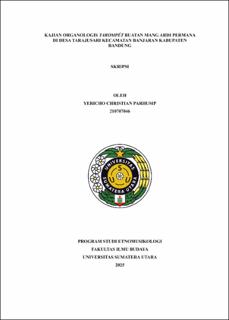| dc.description.abstract | This research discusses the organological study of Tarompét made by mang Ardi
Permana. Tarompet is a wind instrument that has a function as a carrier of song
melodies in pencak silat performances. It is also often used in reak, kuda renggong,
benjang, and reog performances. The instrument belongs to aerophone instruments,
but more specifically belongs to the subcategory of non-free aerophones, which has
five parts: (1) Empét as the sound source, (2) Waring as a barrier or support for the
cheeks of Tarompét players, (3) Palet as a place to store or place the empét, (4) Suling
part which has seven holes and functions as a tone regulator, (5) Lawong as a
loudspeaker The purpose of this research is to identify the structure, making process,
playing technique, and musical function of Tarompét. The research method used is
qualitative with fieldwork, interviews, observation, documentation, and laboratory
work. To identify the structure, manufacturing process, playing technique, and
function, the author uses the theory of musical instrument classification system based
on the main vibrating source of sound proposed by Curt Sach and Hornbostel. The
theory proposed by Susumu Kashima, this theory is used to understand how to
describe musical instruments both structurally and functionally, and the theory of
Alan P. Merriam, this theory is to find out the uses and functions of Tarompét. The
results of the research obtained reveal that the process of making Tarompét made by
Mang Ardi Permana uses the latest sizes and modern tools. Tarompét is made of
hardwood, such as talingkup, teak and surian which is played by blowing using
empét. | en_US |


